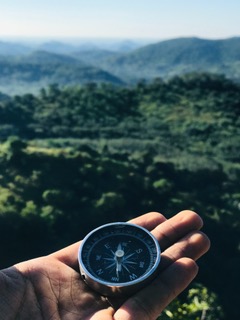Healthy Orienting
Not long ago I sat at my desk, talking with a colleague on FaceTime, we were preparing a workshop in weekly meetings. Suddenly I hear close by an unusual sound as if something was sliding. Despite a somewhat unreliable memory when we are under stress, I will try to summarize how I remember my reactions that must have all occurred within seconds. I am pretty certain that I made a sound, because my colleague asked immediately – are you alright? With some alert tension, I rose up from my chair and looked to the corner from which the sound came. I remember being in a half standing, slightly crouching position, my muscles were engaged. I also checked the skylight above to see if something was sliding down the roof, my neck was not relaxed in this moment! In the end, I realized in astonishment that an object that is always leaning in the corner had slid down onto the floor; there was no damage, it was just an unusual, unexpected event. The threat was over, I could relax and sit down.

My colleague and I laughed, because we were actually in the process of preparing a presentation about working with traumatic events in the framework of the Alexander technique. What a great example of the orienting response had just presented itself! Was my reaction mere exploratory orienting? No, it was fueled by a much higher charge in my nervous system, including a typical startle and some defensive mechanisms; I had gotten ready to jump, attack or run.
The orienting responseis a well-established term in behavioral psychology. It is defined as an organism’s immediate response to a novel stimulus in the environment. In animals, this includes signs of attention like pricked ears, head turning towards the stimulus, increased muscle tension and physiological changes like increased heart rate, pupil dilation and altered skin conductance. From an evolutionary perspective, this mechanism is useful in reacting quickly to events that call for immediate action.
Preparatory orienting is a reaction to novelty; the individual stops and orients towards the stimulus to evaluate if it is threatening. An immediate startle response might occur, if the stimulus is perceived by the nervous system as having a higher charge. If there is an actual threat present, the movement from orienting to threat perception to active defense might happen in milliseconds.
It has been observed that people who have lived through trauma, might experience what is called boundary ruptures; these can be like blind spots in awareness or movements; we can often observe an inability to move smoothly through head and eye movements. Some people have repeatedly accidents on the same side or of the same kind, which might indicate a loss in awareness and defensive orienting abilities.
In Alexander Technique sessions, we are restoring easy and free movements of the head on top of the neck, which translate into good mobility of the whole body in all directions. We are engaging the vestibular system for balance. We are building a connection to the ground and from the ground up through an intelligent approach to posture and the release of tension. We are aiming to restore appropriate muscle tone that adapts to the activity at hand. We are encouraging students to use their eyes, to look out, to actively see, to perceive the world. Our work quiets the mind and activates the calming parasympathetic (rest and digest) nervous system.

Sessions with an Alexander technique teacher can help anybody to actively use their full expression and liveliness in connection with the world around them and to restore better overall functioning after traumatic events like falls or other accidents.


Are you sure your web address is spelt correctly? Technqiue….????
Phew! Thank you Robin! it took me a while to see and remember your comment, then find and fix this error. Thank you very much. I have no idea when this typo sneaked in or how long it was there!
Pingback:Why Do We Tense - Because We Are Human - Alexander Technique and Somatic Experiencing in Cheshire, CT